About La Maddalena
La Maddalena is the name of the principal island of an archipelago off the north-eastern tip of Sardinia. The archipelago is also known as La Maddalena, and consists of over sixty islands, islets and rocks. In the past the islands have been important strategic naval and military bases; now they are an attractive and fairly low-key holiday destination. The most famous attractions are the beautiful unspoiled beaches, the blue seas and the final home of Italian hero Giuseppe Garibaldi, on the island of Caprera.
La Maddalena tourist information
The Maddalena archipelago lies off the north-eastern corner of Sardinia, close to the Costa Smeralda. The cluster of rocky islands lies in famously beautiful waters, clear and shimmering with a range of blue and turquoise hues. There are many fine sand beaches, some of them romantically isolated, and the islands are popular for boating, swimming and sunbathing holidays. The scenery here is memorable; a striking land and seascape where granite outcrops enclose patches of turquoise sea “as blue as the mantle of the Madonna”. Weathered by wind and sea, the granite has formed itself into bizarre shapes, while currents and geology have formed the islands’ famous beaches, each with a different sand texture and colour.
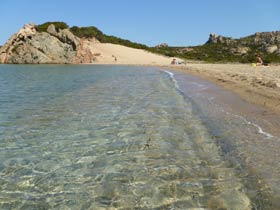
The principal island of the archipelago is La Maddalena itself, which has a substantial main town of the same name, and a choice of hotels. There are a few dwellings on the adjacent island Caprera and some summer homes on another island, but otherwise the remaining islands are uninhabited and unspoiled, preserved and monitored by wardens and national park authorities.
La Maddalena is reached by frequent car ferries from the port town of Palau, a journey which takes just twenty minutes. Palau is connected by bus to Olbia, an hour away, which has an international airport. In the summer there are direct buses from Olbia Airport to the port in Palau; at other times visitors will need to change buses in Olbia (more detailed travel information below).
Things to see and do
The islands are a summer destination, and most tourist services and accommodation close down between October and May. The shoulder seasons – May, early June and September-early October can be very pleasant times for visiting the islands, with fine weather and emptier beaches, but buses and boat trips will run less frequently than during the busy July-August Italian holiday period.
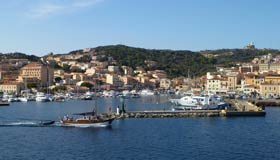
La Maddalena is quite a large island with several very appealing sandy beaches. These all lie outside the town, but are easy to reach thanks to a panoramic circular bus service (more practical information below).
More isolated beaches on the other islands can be reached by boat – if you are lucky enough, your own. Gommoni (rubber dinghies with motors) can be hired along the waterfront in La Maddalena; it is also possible to hire a small boat with a skipper.
Organised boat trips depart every day (sometimes less often outside peak season) from the waterfront in La Maddalena. boards and sales-people advertise the excursions, though the offering and price is basically the same. Boats leave in the morning, cruise through the islands stopping at two or three beaches for long bathing/exploring breaks, and lunch (usually seafood pasta) is provided on board. This is a great way to see the island group, atmospheric uninhabited islands and some beautiful isolated beaches – although you will be sharing them with your fellow passengers and those of other boats.
Museums and sights: Caprera and La Maddalena
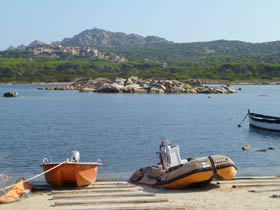
After the beaches, the principal tourist sight in the islands is the Casa Garibaldi on the island of Caprera. This long rocky island is adjacent to La Maddalena, and the two islands are connected by a long causeway and bridge. Giuseppe Garibaldi, the hero of the Risorgimento, was so taken with this unpromising lump of arid rock and scrub that he bought a chunk of the island and built a house there, to which he brought his 40-years-younger last wife, and where he died. His home is open to the public, and visitable on guided tours (generally in Italian, with an information pamphlet in English). It’s a fascinating time capsule of a place, with all sorts of oddments on display, from a plaster cast of a bullet which injured Garibaldi to the bed in which he expired. His tomb, along with other family graves, is outside the villa. There are a bus stop, a small bar and toilets a few yards from the entrance, with car parking along an access road.
Further south on Caprera, at a small settlement called Stagnali, is a new complex of minor museums, likely to be further developed in the future. Housed in old military barracks, and reachable by the Caprera bus, the museums at Stagnali are worth a visit if you are interested in geology, want to know the islands better, or simply want to take a look at this out-of-the-way spot. There is a Museo Geo-Mineralogico-Naturalistico which contains mineral specimens and other curiosities including a display of sand samples from many of the archipelago’s beaches.
On the island of La Maddalena there aren’t many specific cultural attractions. A naval history museum is closed at the time of writing. It’s worth exploring the central pedestrian lanes of the town, where visitors can enjoy a drink at outdoor tables and watch the island’s life. The market, selling fresh seafood and other products, is also worth a look. Lanes with a historic feel lead uphill, and on a raised bit of ground is an intriguing fortress, perhaps one of the island’s oldest fortifications, now an anonymous private residence of which you can get glimpses from the streets below. The parish church has a small museum of religious art.
The islands are dotted with old military fortifications, and armed with a map and a means of transportation, some of these would make interesting sites to visit. The islands’ naval history encompasses a a proud defeat of a French assault led by Bonaparte in 1789, a lengthy offshore sojourn by Nelson’s fleet, and a US naval base, closed in 2008. There are also the remains of a historic quarry, along with its jetty, on La Maddalena. In a bookshop in La Maddalena I found a book (in Italian) of walking excursions on the islands visiting various historic points of interest. Caprera, kept as a nature reserve, is the best destination if you want to explore on foot. It’s popular with La Maddalena residents, who cross to Caprera for morning jogs and constitutionals. We found a leaflet I sentieri di Caprera detailing the island’s footpaths at the Stagnali museums.
Beaches
For most visitors, the principal attraction of the islands is their coastline. A good number of lovely, unspoiled beaches dot the shores of La Maddalena, Caprera and the other islands. Several very attractive beaches are easily accessible by bus – if you are having trouble deciding where to go, local advice will be very helpful. Some beaches have seasonal cafe-bars; most have no facilities, just sand, rock and enticing sea.
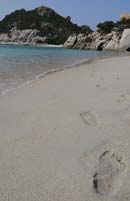
On La Maddalena, two lovely beaches alongside bus stops are Spalmatore and Monte Rena. Spalmatore, with a seasonal cafe-restaurant-disco and a kiosk bar alongside (both closed when we visited in late September) is an attractive curve of sand enclosed in a bay, sloping very slowly into clear water. The headland to the north, easily reachable on foot, is an interesting spot to explore with footpaths, a ruin and some of the islands’ characteristic weathered rock formations. A less-visited yellow sand beach can be reached down a steep path below the headland. Monte Rena, on the north coast of La Maddalena, has two attractive sandy beaches separated by a rocky spur. It has gritty sand dotted with tiny shells, yellow broom and flowers behind beach and a kiosk bar (still open when we visited).
The panoramic bus ride around La Maddalena is very pleasant, and you might wish to do a circuit, viewing the beaches out of the windows, before making a return trip to your chosen beach. Ask the bus driver for the stop you require; we found them very helpful.
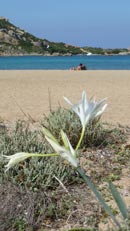
Some highlights of the other islands include Cala dei Corsari on the island of Spargi, a gorgeous bay with several small sandy beaches, windblown rock formations and military ruins. At the heart of the islands is the Piscine naturali, a stretch of sea almost enclosed by islets and islands, where the water is so clear you can see the seabed. Although these beaches feel remote and unspoiled, they are popular stops for boat excursions and can become busy and noisy when these boats disgorge their passengers for an hour. Once the trippers have left, however, peace once more descends.
The beaches on the islands typically descend very gradually into clean, transparent water. However, since most are unattended, bathing is at one’s own risk. String of coloured buoys prevent boats from landing on the marine reserve’s beaches and provide some protection for swimmers. Red buoys indicate beaches which are totally out of bounds for their own protection like, at the time of writing, the ‘pink beach’ Spiaggia Rosa on the island of Budelli.
Island practicalities
La Maddalena has a tourist information office by Cala Gavetta, the narrow historic harbour now used as a marina for yachts. Opening hours are restricted (try to visit in the morning) but you can obtain maps, opening times and bus timetables here.
Turmo travel run two bus routes from La Maddalena town, with a stop by Garibaldi’s column (the Colonna Garibaldi) on the corner near the car ferry ticket office. One route, the panoramica, circles the island of La Maddalena, with handy stops for beaches. The trip is very scenic and is worth doing as an activity in itself. Two of the nicest beaches which can be reached from the bus are Spalmatore or Monte Rena – a tour on the bus will give you good views of these beaches to help you choose. The other bus route crosses the bridge to Caprera. Printed timetables, from the tourist information office or from the Turmo website, are very useful for planning your day. Note that bus frequency varies throughout the year and there may be a long gap between buses at lunchtime. Bus tickets can be bought from a tabacchi shop by Cala Gavetta and also – at a higher price – from the bus driver.
Food and drink
There are several restaurants and bars in La Maddalena town, most of them pleasant though rather touristy. ‘Fast’ food is actually a good alternative here, with tasty and cheap lunch options such as hot focaccia slices at La Focacceria on Via Garibaldi. Sergent Pepper’s, on Via XX Settembre is a good unpretentious pizzeria offering takeaway and outdoor tables for an excellent-value meal.
During the summer you will find cafe-bars alongside some beaches, but if you want to make up a picnic, the town’s take-away food stores, a supermarket opposite the car ferries (pick up some Sardinian wine) and the fresh food market are all good places to shop.
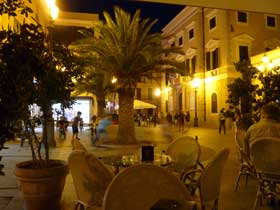
Travel to La Maddalena
Car ferries to La Maddalena from Palau are operated by three different companies: Enermar, Saremar and Delcomar.
In the summer months there is a direct bus service between Olbia Airport and Palau, operated by Turmo Travel. There are more frequent all-year-round services run by ARST from central Olbia to Palau; first catch the airport bus into Olbia, then purchase your ticket in a bar and take the ARST bus on Corso Vittorio Veneto. Buses continue along the coast to the seaside resort Santa Teresa Gallura.
Transferring from bus to ferry in Palau couldn’t be easier. The bus stop is at the port, by the water’s edge. Car ferries to La Maddalena depart from a jetty a few yards away. These also carry foot passengers, and have indoor cabins and outdoor decks for admiring the views. Look out for ‘The Bear’, a remarkable rock formation in the hills. There is an efficient Stazione Marittima building, like a kind of shopping mall, with ticket desks for the three ferry companies, a bar, shop and toilets. During the daytime, ferries leave at approximately fifteen-minute intervals; by glancing outside or looking at the displayed times you can see which company operates the next departure. Look out for discounts on return tickets, advance purchases or for other categories of travellers (our hotel had a deal with Enermar).
During the summer, there are boat trips to La Maddalena from nearby seaside resorts in Sardinia. These excursions, like the one described above, usually last a full day, tour various islands and beaches and allow time for swimming. The islands are sometimes visited on cruise ship excursions, and would make a feasible independent day trip from Olbia using public transport, provided you check bus timetables in advance.
I visited La Maddalena on a tour of Sardinia, travelling here from Castelsardo via Santa Teresa Gallura, then continuing to Olbia.
Hotels and places to stay
We stayed at the comfortable four-star Hotel Excelsior, right opposite the car ferry port in La Maddalena.
> Check hotel availability on La Maddalena

On this site
Hotel Excelsior, La Maddalena – my review
Useful links
Giuseppe Garibaldi (Wikipedia)
